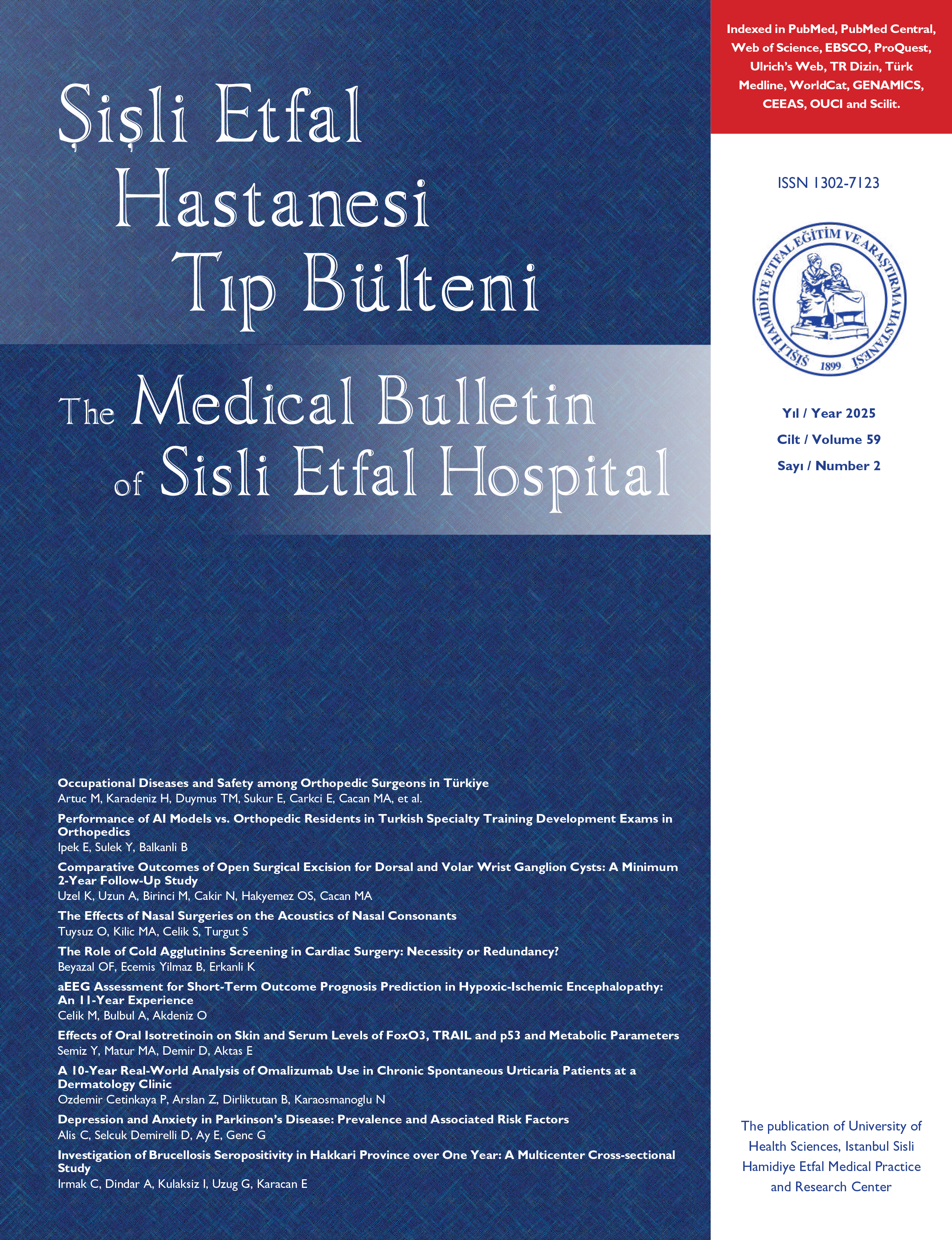
Assessment of Health-Related Quality of Life in Patients with İdiopathic Hirsutism Compared to Patients with Polycystic Ovary Syndrome
Muhammed Masum Canat1, Hazan Erhan2, Ceren Yarkutay Turkkan2, Dilek Canat3, Alper Ozel4, Feyza Yener Ozturk1, Yuksel Altuntas11Department of Endocrinology and Metabolism, University of Health Sciences Türkiye, Sisli Hamidiye Etfal Training and Research Hospital, Istanbul, Türkiye2Department of Internal Medicine, University of Health Sciences Türkiye, Sisli Hamidiye Etfal Training and Research Hospital, Istanbul, Türkiye
3Department of Dermatology, University of Health Sciences Türkiye, Basaksehir Cam ve Sakura City Hospital, Istanbul, Türkiye
4Department of Radiology, University of Health Sciences Türkiye, Sisli Hamidiye Etfal Training and Research Hospital, Istanbul, Türkiye
Objective: Hirsutism affects 515% of women of reproductive age. Health-related quality of life (HQOL) is a multidimensional assessment of well-being that considers the physical, social, and emotional aspects associated with a specific disease. The aim of this study is to evaluate HQOL in patients diagnosed with idiopathic hirsutism (IH) and compare it with patients diagnosed with polycystic ovary syndrome (PCOS).
Methods: This cross-sectional observational study was performed on 183 female individuals, consisting of 51 patients diagnosed with idiopathic hirsutism, 76 patients diagnosed with PCOS, and 56 healthy volunteers. Participants with a history of neuropsychiatric disorders, under 18 and over 45 years of age, during pregnancy and lactation, with any chronic disease that could interfere with diag- nostic laboratory tests, and who had previously been treated for IH or PCOS were excluded from the study. Demographic, anthropo- metric, laboratory, and clinical data on the cases were recorded. The Short Form-36 (SF-36) questionnaire, the Beck Depression Inven- tory (BDI), and the Beck Anxiety Inventory (BAI) were administered in a face-to-face interview by related authors involved in the study. Results: The mean age, level of education, lifestyle, and marital status of all three groups were similar. There were no significant differ- ences in body mass index (BMI) or waist circumference between the groups. Mean modified Ferriman-Gallwey (mFG) scores were similar in the IH and PCOS groups. In the IH patients, the general health and mental health domains of the SF-36 questionnaire scores were sig- nificantly lower than in the control group (p<0.001 and p=0.026, respectively). When the SF-36 questionnaire scores were compared be- tween the IH and PCOS groups, the general health and role emotional domains were significantly lower in the PCOS group (p=0.013 and p<0.001, respectively), and the other domains were similar. All SF-36 questionnaire domains were significantly and negatively correlated with BMI and waist circumference measurements in IH patients. Both BDI and BAI scores were significantly and positively correlated with BMI (r=0.348, p<0.001, and r=0.162, p=0.012, respectively) and waist circumference (r=0.326, p<0.001, and r=0.344, p<0.001, respective- ly). Six out of eight domains of the SF-36 QOL scores were significantly and negatively correlated with the mFG scores.
Conclusion: Patients diagnosed with IH have impaired HQOL, similar to patients diagnosed with PCOS. Improving HQOL should be a goal when deciding on a management approach for hirsutism, which is one of the most common reasons for referral to endo- crinology and dermatology outpatient clinics.
İdiopatik Hirsutizmli Hastalarda Sağlıkla İlişkili Yaşam Kalitesinin Polikistik Over Sendromlu Hastalara Kıyasla Değerlendirilmesi
Muhammed Masum Canat1, Hazan Erhan2, Ceren Yarkutay Turkkan2, Dilek Canat3, Alper Ozel4, Feyza Yener Ozturk1, Yuksel Altuntas11Türkiye Sağlık Bilimleri Üniversitesi, Şişli Hamidiye Etfal Eğitim ve Araştırma Hastanesi, Endokrinoloji ve Metabolizma Kliniği, İstanbul2Türkiye Sağlık Bilimleri Üniversitesi, Şişli Hamidiye Etfal Eğitim ve Araştırma Hastanesi, İç Hastalıkları Kliniği, İstanbul
3Türkiye Sağlık Bilimleri Üniversitesi, Başakşehir Cam ve Şakura Şehir Hastanesi, Dermatoloji Kliniği, İstanbul
4Türkiye Sağlık Bilimleri Üniversitesi, Şişli Hamidiye Etfal Eğitim ve Araştırma Hastanesi, Radyoloji Kliniği, İstanbul
Amaç: Hirsutizm üreme çağındaki kadınların %5-15'ini etkileyen bir problemdir. Sağlıkla ilişkili yaşam kalitesi (HQOL), belirli bir hastalığa bağlı fiziksel, sosyal ve duygusal yönleri dikkate alan çok boyutlu bir refah değerlendirmesidir. Bu çalışmanın amacı idiyopatik hirsutizm (İH) tanısı alan hastalarda HQOL'yi değerlendirmek ve polikistik over sendromu (PKOS) tanısı alan hastalarla karşılaştırmaktır.
Yöntem: Bu kesitsel gözlemsel çalışma, 51 idiyopatik hirsutizm tanılı hasta, 76 polikistik over sendromu tanılı hasta ve 56 sağlıklı gönüllüden oluşan 183 kadınla gerçekleştirilmiştir. Nöropsikiyatrik bozukluk öyküsü olan, 18 yaş altı ve 45 yaş üstü, gebelik ve emzirme döneminde olan, tanısal laboratuvar testlerini etkileyebilecek herhangi bir kronik hastalığı olan ve daha önce İH veya PCOS tedavisi görmüş olanlar çalışma dışı bırakılmıştır. Olguların demografik, antropometrik, laboratuvar ve klinik verileri kaydedilmiştir. Kısa Form-36 (SF-36) anketi, Beck Depresyon Envanteri (BDI) ve Beck Anksiyete Envanteri (BAI), ilgili yazarlar tarafından yüz yüze görüşmelerle katılımcılara uygulandı.
Bulgular: Ortalama yaş, eğitim düzey, yaşam tarzı ve medeni durum her üç grupta benzerdi. Gruplar arasında beden kitle indeksi (BMI) veya bel çevresi açısından anlamlı bir fark bulunmamıştır. Ortalama modifiye Ferriman-Gallwey (mFG) skorları İH ve PKOS gruplarında benzerdi. İH hastalarında, SF-36 yaşam kalitesi skorlarının genel sağlık ve ruh sağlığı alanları kontrol grubuna göre anlamlı derecede düşüktü (sırasıyla p<0.001 ve p=0.026). SF 36 yaşam kalitesi skorları İH ve PKOS grupları arasında karşılaştırıldığında, genel sağlık ve duygusal rol alanları PKOS grubunda anlamlı derecede düşüktü (sırasıyla p=0.013 ve p<0.001) ve diğer alanlar benzerdi. Tüm SF-36 yaşam kalitesi alanları, İH hastalarında BMI ve bel çevresi ölçümleri ile anlamlı ve negatif korelasyon göstermiştir. Hem BDI hem de BAI skorları, BMI (sırasıyla r=0.348, p<0.001 ve r=0.162, p=0.012) ve bel çevresi (sırasıyla r=0.326, p<0.001 ve r=0.344, p<0.001) ile anlamlı ve pozitif korelasyon göstermiştir. SF-36 yaşam kalitesi skorlarının sekiz alanından altısı mFG skorları ile anlamlı ve negatif korelasyon göstermiştir.
Sonuç: İH tanılı hastaların sağlıkla ilişkili yaşam kalite düzeyleri, PKOS tanılı hastalara benzer şekilde düşüktür. Endokrinoloji ve dermatoloji polikliniklerine başvuruların sık nedenlerinden biri olan hirsutizm için hasta yönetiminde hedeflerden biri de HQOL'yi iyileştirmek olmalıdır. (SETB-2023-08-147)
Manuscript Language: English



















